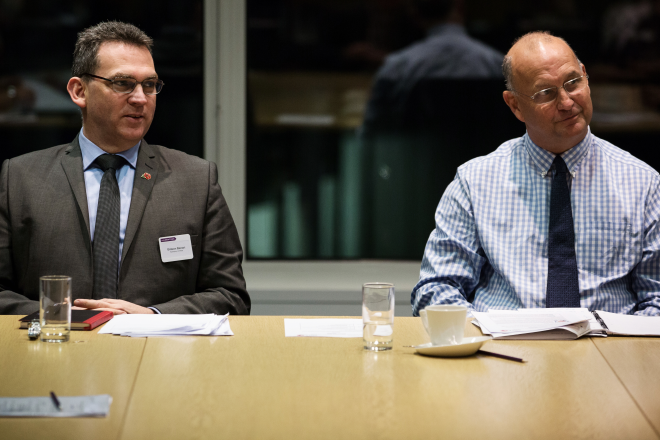
Centre for Analysis of Risk and Regulation (CARR) at the London School of Economics and Gideon Benari, editor, Solvency II Wire, co-chairs of The Governance Trap, outline some of the emerging themes from the discussion.
The emphasis on governance within regulation is closely linked to the assumption that appropriate governance arrangements can moderate behaviour to align it with wider regulatory purpose; for example, responsible behaviour or promoting competition. This is in turn is linked to questions of individual accountability.
If governance is to become an effective and encompassing tool in the arsenal of regulators it must be measured and tracked. The Governance Trap: tracking behaviour and change explores practical ways of addressing the conflict between the flexibility and subjectivity of governance ideas and the need to create tangible and measurable metrics.
This discussion builds on the first event in the series, The Governance Trap and the future of regulation, which outlined some of the principles and challenges of good governance.
One of the main challenges identified in the discussion was how to develop a more nuanced understanding of governance to make it a more effective approach to regulation. Exploring how governance can be tracked and monitored adds to that nuanced understanding, and can help to apply governance in regulatory frameworks more effectively.
The main themes of the discussion are explored in this introduction to a volume of articles by a number of the participants in the discussion.
The event was held in London on 3 November 2016, hosted by ![]()
List of participants at the event
Gabriel Bernardino, chair, EIOPA
Ed Humpherson, director general for regulation, The Statistics Authority
Kathryn Morgan, director of regulatory operations, Gibraltar Financial Services Commission
Wijnand Nuijts, head of department, Expert centre Governance, Behaviour and Culture, De Nederlandsche Bank
Jan Parner, deputy director general, Danish Financial Supervisory Authority
Elisabeth Stheeman, senior advisor, Bank of England
Philip Yelland, executive director of regulation, The Law Society of Scotland
Co-chairs
Gideon Benari, editor, Solvency II Wire
Mike Power, professor of accounting, Centre for Analysis of Risk and Regulation, LSE
The problem with measuring governance
Assessing the governance of an organisation is like assessing the quality of a lake to which you have limited access. Without being in it, you must rely on clues from the surface and surroundings to tell you what is going on below. In much the same way supervisors must develop a set of tools and practices that will allow them to evaluate what is going on inside an organisation.
The difficulty in tracking and measuring governance and behaviour lies in balancing the need for concrete metrics with the subjective and often nebulous concept of good governance as a feature of organisational culture.
The topic is explored along four broad themes that emerged from the discussion: structure and process, tangible metrics, individuals and disclosure.
Structure and process

Having the right structure and process that facilitate clear lines of responsibility and accountability is an essential part of creating and maintaining good governance.
Organisational structure and process can, therefore, provide an effective proxy for the quality of the underlying governance. Unsurprisingly, regulation in many sectors contains prescriptive structural requirements for setting systems of governance in place.
Structure can be monitored and tracked by reviewing organisational charts, lines of reporting and related processes. The review can also help to detect conflicts of interests. For example, by ensuring that functions such as audit and quality control operate independently. Tracking changes over time can also give an indication of how responsibilities and organisational thinking evolves.
The quality of process can similarly be a good proxy for the quality of governance. Like structure it can be tracked and monitored by reviewing documentation and reporting. Making sure the right processes are in place and developing methods to check their application can reinforce and inform the findings related to structure.
However, it was noted that many company failures occurred even when thorough structures and processes were in place, emphasising the importance of assessing the underlying behaviours in order to really understand the quality of governance.
Furthermore, a number of participants pointed to the importance of stories and narratives to enhance the understanding of the company structure and processes. Narratives help identify and explain the underlying motives and can give a better sense of attitudes and behaviour within the organisation.
Tangible metrics
The quality of governance can be assessed by tracking tangible metrics that are indirectly related to both internal and business outcomes. These can often reveal information about underlying behaviour and culture.


For example, the quality of financial accounts and compliance with financial requirements can be indicative of underlying practices and control disciplines involved in preparing the accounts.
Some supervisors find indicators of potential consumer detriment or of supplier performance to be useful proxies for the quality of governance.
Training and education can also be an effective proxy for good governance. Random sampling of training and education records can help to detect individuals or departments where on-going training and professional development are lacking. These can also be tested by directly reviewing the technical skills of individuals.
Indviduals
Individual behaviour is at the core of good governance and culture. On-site inspection and review of the premises are probably the most effective and direct form of gauging what is happening in the organisation. They can also identify other challenges and arising issues.
Supervisors also recognise the importance of the inspector’s “nose” or “gut feeling” in the process. However, this is a skill that usually takes years to develop.
In addition to challenging the technical skill of individual directors and senior managers, supervisors can also engage directly with the board to support and promote good governance through provision of guidance and training. Such engagement may be particularly effective for new entrants into competitive markets.
That culture and attitude are set by the “tone at the top” was fairly universally accepted across all sectors, but further exploration is needed to understand how this impacts the organisation.
The discussion about the role of the Board and Non-Executive Directors raised questions about the need to understand where the power in the organisation resides. While monitoring the Board’s activity (through reviewing minutes and inspections) may be effective, supervisors must gain a better understanding of how those decisions are then disseminated and implemented across the organisation.
Several supervisors have developed methodologies to assess board effectiveness and the behavioural risks that may be caused factors such as leadership, group dynamics and the quality of decision-making.
Disclosure


Public disclosure can also be an effective tool to evaluate governance in a number of ways.
The quality and transparency of the disclosures provide a good indicator of the underlying governance and culture.
Similarly, publishing open statements committing to delivery of specific goals or a particular behaviour (e.g. customer care, or open and transparent process) can help to hold the organisation to account as well as show its own belief in its ability to deliver.
Clear disclosure requirements and a pre-defined disclosure schedule are also an effective form of target setting that can be monitored if breached.
In the discussion it emerged that in some cases public disclosure can be an extremely effective mechanism to drive compliance and good corporate behaviour.
Common themes


Although governance and culture do not naturally lend themselves to be tracked and monitored, the discussion demonstrates that by applying a range of methods to suit the type and size of organisation, supervisors can make significant inroads into gaining a better understanding of a firm’s governance. The remaining articles in this volume explore some of these methods, highlighting the importance of cross-sector learning in tackling common challenges.
Articles in this series
Gabriel Bernardino, chair, EIOPA on the importance of the tone from the top in setting organisational culture.
Ed Humpherson, director general for regulation, The UK Statistics Authority on the surprising effectiveness of soft power.
Kathryn Morgan, director of regulatory operations, Gibraltar Financial Services Commission on the value of narratives for understanding and measuring governance.
Wijnand Nuijts, head of department, Expert centre Governance, Behaviour and Culture, De Nederlandsche Bank on alternative methods for supervision of behaviour and culture.
Jan Parner, deputy director general, Danish Financial Supervisory Authority on integrating stories with governance structures.
Elisabeth Stheeman, senior advisor, Bank of England on the role of senior management and the importance of cross sector learning.
Philip Yelland, executive director of regulation, The Law Society of Scotland on tracking and monitoring governance in the legal sector.
‘The Governance Trap: Tracking Behaviour and Change’ is the second event in a series of collaborations between Solvency II Wire and the Centre for Analysis of Risk and Regulation (CARR) at the London School of Economics.
The event was held in London on 3 November 2016, hosted by ![]()
![]()
![]()
If you’d like to learn more about or read articles from the first event in this series, The Governance Trap and the Future of Regulation, please click here.
To receive the next article in the series directly to your inbox and subscribe to the Solvency II Wire mailing list for free, click here.






